
Being part of the hyper-connected world that we live in today involves using digital devices and generating data regularly. The essential nature of these digital technologies means they must be secured to ensure privacy and protection from people who are willing to steal and compromise data for nefarious purposes.
In response to the growing threat of attacks from malicious actors looking to compromise data security and other critical infrastructure, cybersecurity experts have devised guidelines to detect and respond to these threats. These guidelines form the basis for what the industry refers to as cybersecurity frameworks.
What is a Cybersecurity Framework?
A cybersecurity framework is a set of standards, guidelines, and procedures put together by a body of professionals to help organizations understand and manage their exposure to cybersecurity risk. These frameworks are an essential tool for those looking to design or refine their security policies in line with industry best practices.
Individuals or organizations that try to secure their digital assets by relying solely on their capabilities can quickly become overwhelmed with defining an appropriate and effective response to every threat. However, with the help of one of the top cybersecurity frameworks built on the cumulative experience of several industry experts, IT managers can simplify this monumental task.
Just like a typical framework is meant to be a foundation or support system, the best security framework is supposed to provide you with a reliable way to build out your cybersecurity program.
Goals of a Cybersecurity Framework
The primary goal of most cybersecurity frameworks is to improve the industry’s resilience to cyber attacks. They achieve this by helping even the most minor organizations implement robust security controls by leveraging the framework guidelines. The experts involved in creating these standards would typically be out of the reach of smaller companies, but the framework makes it possible for everyone to benefit from their expertise.
Another purpose for cybersecurity frameworks is to help these entities achieve regulatory compliance. As a direct result of the increasing rate of data breaches involving business and personal data, regulatory bodies from several sectors have developed information security legislation that organizations under their jurisdiction must meet. While these rules may vary between industries, they are almost always based on cybersecurity frameworks.
An excellent example of this is the New York Department of Financial Services 23 NYCRR Part 500, a body of cybersecurity regulations for financial services companies built on the NIST (National Institute of Standards and Technology) Cybersecurity Framework.

Top Cybersecurity Frameworks for 2022
Now that we understand the importance of cybersecurity frameworks, here are the top five frameworks to consider for your organization in 2022:
1. NIST Cybersecurity Framework
The NIST Framework’s primary objective is to help organizations develop a consistent and iterative approach to identifying, assessing, and managing their cybersecurity risk. The critical infrastructure it’s meant to protect can be controlled by public or private sector organizations of different sizes, complexity, and technical competence. Therefore, NIST designed the framework to be applicable regardless of these factors.
Another advantage of the approach used to develop this framework is that it is technology-neutral in its application. Instead, it makes use of universally applicable terminology to help IT managers do the following:
- Describe their current cybersecurity posture.
- Describe their cybersecurity goals.
- Identify and prioritize opportunities for improvement.
- Assess progress toward their cybersecurity goals.
- Communicate cybersecurity risk to internal and external stakeholders.
This broad approach to securely managing risk makes the NIST security framework the best starting point for organizations in any sector looking to safeguard their infrastructure.
You can access the framework documents from the NIST website to get started on this path.
2. HIPAA
The Healthcare Insurance Portability and Accountability Act (HIPAA) is a piece of United States legislation that standardizes how healthcare organizations handle information. As information technology began to play a more prominent role in the industry, this regulation evolved to include the HIPAA Security Rule. This rule requires healthcare providers and businesses to maintain the confidentiality, integrity, and security of electronically protected healthcare information (ePHI).
- Administrative Safeguards in the form of policies and procedures that show how an entity will comply with the act.
- Physical Safeguards that provide physical access control to protected data.
- Technical Safeguards to protect the hardware and software systems that process, store, and transmit protected data.
For organizations in the healthcare sector that manage personally identifiable information (PII), compliance with the HIPAA Security Rule is mandatory.
3. PCI-DSS
If you operate in the financial services industry and your business involves handling cardholder information, then you should know about the Payment Card Industry Data Security Standard (PCI-DSS). The Payment Card Industry Security Standards Council (PCI SSC) put together this framework in response to the growing number of credit card data breaches.
Entities that accept or process payment cards and are looking to comply with the PCI-DSS framework must meet these six control objectives:
- Build and maintain a secure network and systems.
- Protect cardholder data.
- Maintain a vulnerability management program.
- Implement strong access control measures.
- Regularly monitor and test networks.
- Maintain an information security policy.
The volume of online transactions is slowly outpacing physical transactions making compliance with this framework necessary for organizations that want to move their payment operations businesses online.
The PCI SSC has a great library of resources to learn more about the framework and its requirements.
4. ISO/IEC 27001/ISO 27002
The International Organization for Standardization (ISO) is a non-governmental body responsible for developing globally recognized technical standards for everything from manufacturing to social responsibility. Based on the broad scope of their duties, you can be sure that they have standards for cybersecurity.
The ISO/IEC (International Electrotechnical Commission) 27001 and ISO 27002 standards belong to the much broader ISO 27000 series of standards that deal with information security. ISO 27001 covers the requirements for designing, implementing, maintaining, and continuously improving an information security management system (ISMS). ISO 27002, on the other hand, outlines the information security standards and practices that organizations can implement with an ISMS.
Similar to the NIST CSF, the ISO frameworks apply to organizations of all types and sizes. They involve analyzing an organization’s information security requirements based on the following factors:
- An assessment of organizational risk to identify threats, level of vulnerability to them, and the likelihood of occurrence as well as their potential impact.
- The legal and contractual obligations an organization has to meet.
- The internal processes, procedures, and business requirements for information management an organization uses for its operations.
This analysis will determine the appropriate information security controls to deploy an information security management system that works for the entity.
5. CIS Controls Framework
The Center for Internet Security (CIS) developed its Critical Security Controls framework by applying a crowdsourcing model to identify the most prevalent cyber threats and define security measures to protect against them.
The most recent version of this framework, CIS Controls Version 8 (as of May 2021), consolidates these safeguards into eighteen control groups based on activities rather than devices, technologies, or people.
Some of these activities include:
Over time, the framework became more accessible by sorting the safeguards for each CIS Control into Implementation Groups based on an organization’s level of technical competence and available resources. This level of detail ensures that you can apply the appropriate security measures to your IT infrastructure despite your level of expertise.
Liquid Web Knows Compliance Hosting (HIPAA and PCI)
For organizations that need secure web hosting to meet their compliance requirements for any of the frameworks above, look no further than Liquid Web. We have a broad selection of Security & Compliance Add-Ons to meet your needs and over a decade of experience satisfying customers’ expectations.
[ad_2]
Source link







